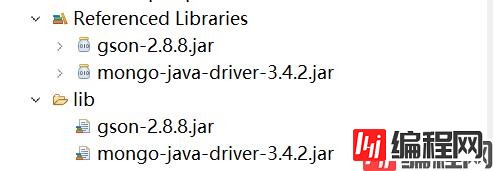Python 官方文档:入门教程 => 点击学习
目录一、Java链接mongoDB二、查看库,查看集合三、Java对MonGoDB增删改查1. 添加数据2. 删除数据3. 修改数据4. 查询数据一、Java链接MongoDB 1.
1. 导入Mongo驱动包

2. 获取Mongo链接对象
MongoClient mc = new MongoClient("localhost",27017);
3. 关闭链接
mc.close();
1. 获取库对象
MongoDatabase db = mc.getDatabase("myschool");
2. 获取库中表的集合
MongoIterable<String> listCollectionNames = db.listCollectionNames();
MongoCursor<String> iterator = listCollectionNames.iterator();
while (iterator.hasNext()) {
System.out.println(iterator.next());
}
a. 添加一条数据
//创建对象
Student s = new Student();
s.setSid(1);
s.setSname("王俊凯");
s.setBirthday(new Date());
s.setSsex("男");
s.setClassid(2);
//将数据转换为JSON格式
Gson gson = new GsonBuilder().setDateFORMat("yyyy-MM-dd").create();
String json = gson.toJson(s);
//获取集合对象
MongoCollection<Document> collection = db.getCollection("student");
//添加一条数据,将json格式转换为document对象
collection.insertOne(Document.parse(json));
b. 添加多条数据
//存入数据
List<Document> dlist=new ArrayList<Document>();
for(int i=0; i<3; i++){
Student s = new Student();
s.setSid(Integer.toString(i+1));
s.setSname("王源");
s.setBirthday(new Date());
s.setSsex("男");
s.setClassid(1);
//将数据转换为json格式
Gson gson = new GsonBuilder().setDateFormat("yyyy-MM-dd").create();
String json = gson.toJson(s);
dlist.add(Document.parse(json));
}
//获取集合对象
MongoCollection<Document> collection = db.getCollection("student");
//添加多条数据
collection.insertMany(dlist);
a. 删除一条数据
//获取集合对象
MongoCollection<Document> collection = db.getCollection("student");
Student s = new Student();
s.setSid(1);
Gson gson = new GsonBuilder().setDateFormat("yyyy-MM-dd").create();
Bson bson = Document.parse(gson.toJson(s));
DeleteResult deleteOne = collection.deleteOne(bson);
b. 删除多条数据
//获取集合对象
MongoCollection<Document> collection = db.getCollection("student");
Student s = new Student();
s.setSname("王源");
Gson gson = new GsonBuilder().setDateFormat("yyyy-MM-dd").create();
Bson bson = Document.parse(gson.toJson(s));
DeleteResult deleteMany = collection.deleteMany(bson);
a. 修改一条数据
MongoCollection<Document> collection = db.getCollection("student");
//一个条件对象
Bson eq = Filters.eq("sname","易烊千玺");
//要修改的数据
Document doc = new Document();
doc.put("$set", new Document("age",22));
UpdateResult updateone = collection.updateOne(eq, doc);
System.out.println(updateone);
b. 修改多条数据
MongoCollection<Document> collection = db.getCollection("student");
//多条件
Bson bson = Filters.and(Filters.gte("age", 20),Filters.lte("age", 40));
//要修改的数据
Document doc = new Document();
doc.put("$set", new Document("sex","男"));
UpdateResult updateMany = collection.updateMany(bson, doc);
System.out.println(updateMany);
a. 全查
MongoCollection<Document> collection = db.getCollection("student");
FindIterable<Document> findAll = collection.find();
MongoCursor<Document> iterator = findAll.iterator();
while(iterator.hasNext()){
System.out.println(iterator.next());
}
b. 带条件查询
MongoCollection<Document> collection = db.getCollection("student");
//一个条件对象
Bson eq = Filters.eq("sname","易烊千玺");
FindIterable<Document> findOne = collection.find(eq);
MongoCursor<Document> iterator = findOne.iterator();
while(iterator.hasNext()){
System.out.println(iterator.next());
}
c. 模糊查询
MongoCollection<Document> collection = db.getCollection("student");
//使用正则表达式进行模糊查找
Bson eq = Filters.regex("sname","易");
FindIterable<Document> find = collection.find(eq);
MongoCursor<Document> iterator = find.iterator();
while(iterator.hasNext()){
System.out.println(iterator.next());
}
d. 分页查询
MongoCollection<Document> collection = db.getCollection("student");
//分页查询
FindIterable<Document> find = collection.find().skip(2).limit(3);
MongoCursor<Document> iterator = find.iterator();
while(iterator.hasNext()){
System.out.println(iterator.next());
}
e. 排序查询
MongoCollection<Document> collection = db.getCollection("student");
//排序查询 1升序 -1降序
Bson bson = new Document("sid",1);
FindIterable<Document> find = collection.find().sort(bson);
MongoCursor<Document> iterator = find.iterator();
while(iterator.hasNext()){
System.out.println(iterator.next());
}到此这篇关于Java连接MongoDB的常用方法详解的文章就介绍到这了,更多相关Java连接MongoDB内容请搜索编程网以前的文章或继续浏览下面的相关文章希望大家以后多多支持编程网!
--结束END--
本文标题: Java连接MongoDB的常用方法详解
本文链接: https://lsjlt.com/news/164550.html(转载时请注明来源链接)
有问题或投稿请发送至: 邮箱/279061341@qq.com QQ/279061341
2024-03-01
2024-03-01
2024-03-01
2024-02-29
2024-02-29
2024-02-29
2024-02-29
2024-02-29
2024-02-29
2024-02-29
回答
回答
回答
回答
回答
回答
回答
回答
回答
回答
0